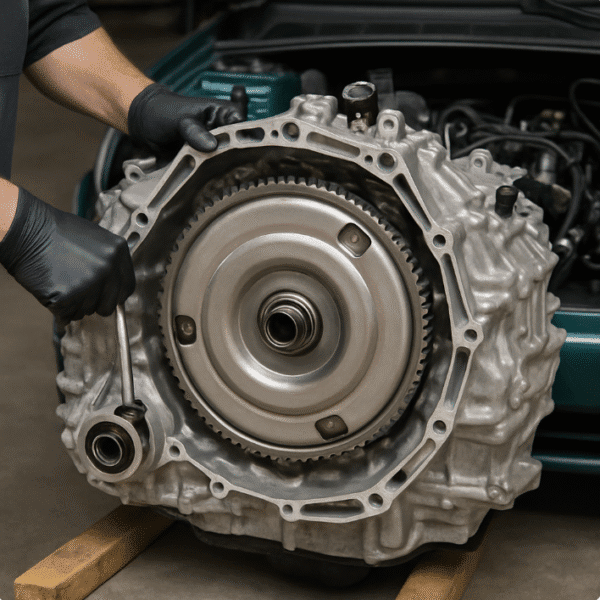
Here’s a practical overview if you’re planning or considering Toyota Camry transmission repair—focusing on common issues, steps, and tips:
⚙️ Common Camry Transmission Issues
✅ Hard or delayed shifting — often caused by worn solenoids, dirty ATF, or valve body problems.
✅ Slipping gears — low fluid, worn clutches, or pump issues.
✅ No movement in Drive/Reverse — possible torque converter, internal clutch, or fluid pressure loss.
✅ Check Engine Light — DTCs related to shift solenoids (P0750–P0765), speed sensors, or torque converter lockup.
✅ Transmission fluid leaks — usually from axle seals, pan gasket, or cooler lines.
🛠️ Basic Repair Steps
1️⃣ Diagnose with OBD-II scanner (Techstream recommended for Toyota) — check codes and live data.
2️⃣ Inspect fluid condition — burnt smell or dark/brown color indicates overheating or clutch wear.
3️⃣ Drain and remove the transmission pan — replace or clean the internal filter/screen.
4️⃣ Replace worn solenoids if shifting issues or codes point to them.
5️⃣ Check valve body — gummed-up passages can cause erratic shifts.
6️⃣ Replace worn clutches or bands — requires full disassembly.
7️⃣ Reassemble carefully, replace gaskets/seals, and refill with Toyota ATF WS (or recommended fluid).
8️⃣ Test drive and verify smooth shifts through all gears.
🔎 Tools & Parts You’ll Need
✔️ Transmission jack
✔️ Torque wrench
✔️ Full gasket & seal kit
✔️ New ATF fluid
✔️ Transmission filter kit
✔️ Solenoid set (if needed)
✔️ Factory repair manual or reliable guide
🔧 DIY or Professional?
🟢 If you’re only replacing the fluid/filter or solenoids, it’s doable at home with good tools.
🔴 If you have major internal damage (clutch packs, planetary gears, or torque converter failure), a professional rebuild or replacement is often more cost-effective and reliable.
✅ Pro Tips
- Always use the correct ATF—Toyota ATF WS or T-IV (depending on model/year).
- Replace cooler lines or flush them if your transmission had debris or overheating.
- Consider replacing or cleaning the transmission cooler to prevent new transmission damage.
- If replacing the transmission, make sure to match the exact model code (e.g., U140E, U241E, etc.) printed on the transmission ID plate.
Sure! Here’s a comprehensive list of Toyota Camry automatic transmission models used across generations (with the most common codes you’ll find on Camrys worldwide). This covers nearly every Camry from the early 1980s to today:
📜 1980s–1990s Camry Transmissions
- A140E – 4-speed electronic automatic (1992–2001 Camry 4-cyl FWD)
- A540E – 4-speed electronic (early V6 models, e.g., 1992–1996)
- A541E – Updated version for later V6s (1997–2001)
- A130L/A131L – Early 3-speed automatics in 1980s Camrys
📜 2000s Camry Transmissions
- U140E/U140F – 4-speed automatics (1999–2006, 4-cyl)
- U151E/U151F – 5-speed automatics (2002–2006, 6-cyl models)
- Aisin U250E – Introduced in late 2000s for some 4-cyl applications
📜 2010s Camry Transmissions
- U760E – 6-speed automatic (2012–2017, 4-cyl)
- U660E/U660F – 6-speed automatic for V6 models
- P310 eCVT (Hybrid) – electronic CVT used on Camry Hybrids from ~2007 onward
📜 2018+ Camry Transmissions
- UA80E – 8-speed automatic (2018–present Camry 4-cyl)
- UA80F – 8-speed automatic for AWD Camry variants
- UB80E – 8-speed automatic in newer V6 Camry
- P710 eCVT (Hybrid) – latest generation electronic CVT for 2018–present Camry Hybrids
🔧 Key Transmission Families
- A-series automatics: Classic hydraulically controlled 3- and 4-speed automatics (A130, A140, A540).
- U-series automatics: Modern electronically controlled 4-, 5-, 6-, and 8-speed units (U140, U151, U660, UA80).
- P-series eCVTs: Specially designed electronic CVTs for Toyota hybrids (P310, P710).
✅ Important Notes
- Toyota often reuses transmission families across multiple models, but gear ratios, valve bodies, or control logic can differ by year/engine.
- Always confirm the exact model code stamped on your transmission housing or check the VIN-specific parts catalog.
- Hybrid Camrys never use conventional automatics; they always use eCVTs (no physical gear shifts).

